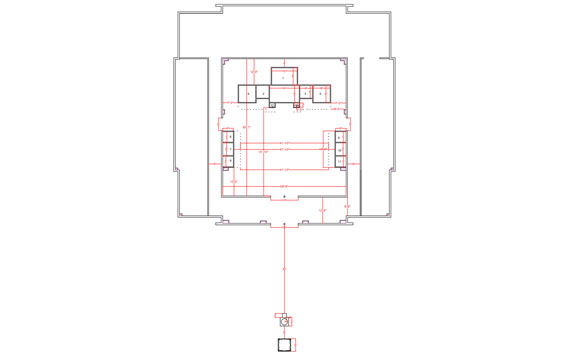Dear Devotees,
Om Namo Venkateshwaraaya!!
Over the last two months, Deity and Architecture Committee members have been in consultations w/ Priest advisors, structural engineers. We had walk through of the temple premises separately with three (3) Priest Advisors (experts in Agama Shastra), Sthapathi, and Structural engineer
Based on these recommendations and discussions, we have written these FAQs to answer most of the questions. It is our humble request that you review the following pages. Every attempt has been made to incorporate all the (unifying) feedback/ advice and commendations received from these sources.
- 1.1. Center: Sri Venkateshwara Swamy/Balaji with Sri Lakshmi and Goda devi on either side of Swamy
- 1.2. Left Side of Balaji: Panchamukha Shiva Lingam
- 1.3. Right Side of Balaji: Maha Ganapathi
- 2.1. Sri Ram Parivar w/ Hanuman
- 2.2. Sri Radha Krishna
- 2.3. Sri Durga
- 3.1. Kumara Swamy/Kartikeya/Murugan
- 3.2. Swayamwara Parvathi Devi
- 3.3. Sri Gayatri devi
1. What will be the Temple layout? (see layout figure below)
1. West Wall
2. North Wall
3. South Wall
2. What are the proposed features of the temple?
- 1. Temple layout, deity locations and dimensions of each enclosure in the temple are per the Agama Shastra guidelines. Temple will have three zones: Mukha Mandapa, Ardha Mandapa, and Garbha Mandapa.
- 2. Bhakta Hanuman/ Bhaktananjaneya as the KshetraPalaka will be outside the temple premises facing the main deity on a pedestal.
- 3. Govinda Stupam
- 4. Dwajasthambam with Garuda in front of it.
- 5. Navagraha w/ their consorts in the temple complex (outside the main sanctum) but inside the structure
- 6. Yagasala
- 7. Pakasala (Kitchen)
- 8. Hair Offering/Donation room (akin to Kalyana Katta in Tirupati). This will be a service provided if the devotees would like to donate hair to Sri Venkateswara Swamy
3. Will there be Pradakshina/Parikrama Paths around the deity?
There will be three Pradakshina paths. This path has been mapped based on agama shastra rules and architectural feasibility.
- 1. The Inner Pradakshina path will be around the west wall deity complex.
- 2. The Outer Parikrama path will encompass all the deities in the sanctum.
- 3. Pradakshana path around Navagrahas
4. What are the unique features of this temple?
- 1. Sri Venkateshwara Swamy with both Lakshmi Devi and Goda Devi, his Dwarapalakas, Garuda vahana and with
- 2. Hanuman as the Kshetra Palaka
- 3. Pancha Mukha Shiva Lingam
- 4. Swayamwara Parvathi Devi
- 5. Venkateshwara Mantra Nama Japakoti Govinda Stupam
- 6. Navagraha w/ their consorts
- 7. Yagasala
- 8. Pakasala (Kitchen) to be separated from pradakshina path to minimize disruption and soundproof it from the main sanctum.
- 9. Hair donation room (Kalyana Katta)
- 10. Meditation room
5. What is Venkateshwara Mantra Nama Japakoti Govinda Stupam?
- 1. We hope to mobilize devotee volunteers to write “Om Venkatesaya Namaha” mantra in Govinda Nama Koti Japa books. Once completed - each book will have Govinda mantra written 100,000 times.
- 2. During the temple pratishtapana, completed Japa books will be placed underground, and a Stupa will be erected above. Devotees will be able to tie “Venkateswara/Govinda Thoram” to this Govinda Stupam
6. What will the deities look like? Where will they be sourced from?
- 1. Agama Shastra guidelines to be followed. It is recommended that deities that-
- a. DO have Abhisheka as part of their pooja pakriya will be made of black stone.
- b. DO NOT have Abhisheka as part of their pooja pakriya will be made of Marble.
- 2. Intention is to source deities from places where the deity originally originated.
7. What architectural changes need to be made?
- 1. Bathrooms need to be moved out of the main temple premises to the side but will remain connected to the main building.
- 2. Side walls remain (per Agama Shastra) and feasibility aspect.
- 3. Kitchen expansion w/ gas line
- 4. All deity enclosures need water drainage w/ oil traps.
8. What is the proposed cost?
- 1. We will be working on getting quotes. Projected costs: TBD
9. How were these deities' names being proposed?
- 1. Deities were finalized by the polling data received from the community.
- 2. The list was discussed with the religious priests, and we made every effort to
include all the deities (Shanmata) as defined by Adi Sankaracharya. Sri Gayatri
Devi was included to reflect Sauram.
Adi Sankara identified that the major cults could be identified in line with six principal deities of the Hindu pantheon – Ganapathyam (the worship of Lord Ganesha), Kaumaram (the worship of Lord Kumara or Karthikeya), Sauram (the worship of the Sun God), Shaktham (the worship of Goddess Shakthi), Shaivam (the worship of Lord Shiva), and Vaishnavam (the worship of Lord Vishnu). These six major streams of Hindu worship are referred to as Shanmatham. - 3. We attempted to include deities that are prominent in (and representative) of different parts of India. We followed Agama Shastra expert advice, all India representation, and tried to create some uniqueness.
10. Next Steps:
- We will have an in-person meeting on June 1, Saturday between 4-6 pm on the temple premises to review this layout proposal.
Thank you for your support in this process.
Deity Committee and Architecture Committee Leads
Proposed Layout (As suggested by Priests)
